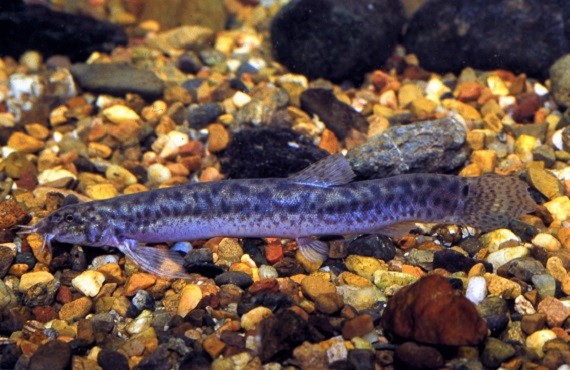Oriental weatherloach
Introduction
 The oriental weatherloach (Misgurnus anguillicaudatus) is a popular freshwater fish kept by many aquarium enthusiasts, however in the waterways of south-eastern Australia it is considered a pest species. Populations of the oriental weatherloach have become established in several NSW rivers.
The oriental weatherloach (Misgurnus anguillicaudatus) is a popular freshwater fish kept by many aquarium enthusiasts, however in the waterways of south-eastern Australia it is considered a pest species. Populations of the oriental weatherloach have become established in several NSW rivers.
Weatherloach have an elongate, cylindrical body and are generally a mottled brownish-yellow colour, with a pale underside, numerous black spots on the back and sides, and a prominent black spot at the base of the caudal fin. They can reach a maximum length of 25 cm but in Australia usually grow to only around 20 cm. Weatherloach are sometimes confused with small eels but can be readily identified by the existence of five pairs of barbels around the mouth and a short dorsal fin. The body is covered in mucus, resulting in difficulty when handling this species.
Males can be identified by an enlarged second fin ray, giving a triangular appearance to the pectoral fin. Females display a more rounded pectoral fin.
The oriental weatherloach is a hardy species that can live in a wide range of environmental conditions. The species thrives in water temperatures ranging from 2-30°C, and has been found in a number of hot springs at temperatures up to 38°C. Waters with low dissolved oxygen are tolerated by the oriental weatherloach, which has the ability to swallow air and utilise oxygen from the atmosphere. The oriental weatherloach is able to burrow to escape predators and move overland to disperse and colonise new water bodies. These characteristics help to increase the distribution of the species and give the weatherloach a competitive advantage over our native freshwater species.
Natural distribution and biology
Oriental weatherloach are native to China, Siberia, Korea, Hainan and Japan. They are widely eaten in eastern Asia and have been introduced into Mexico and the Philippines for aquaculture.
This nocturnal bottom dweller is typically found in still waters with sandy or muddy substrates. The weatherloach feeds on algae, aquatic insect larvae, crustaceans and rotifers.
The weatherloach is a multiple spawner, laying 4-8000 eggs per spawning on aquatic vegetation or mud. With a lifespan in captivity of 13+ years, it is possible for one female to lay up to approximately 100,000 eggs in her lifetime. Due to their relatively high fecundity, hardiness and mobility there is a high risk of self-sustaining populations becoming established once the weatherloach is introduced into new areas.
Where are they in NSW?
After colonising the Ginninderra Creek in the ACT in 1986, the oriental weatherloach spread into tributaries and consequently into NSW waters soon after. Within NSW, populations of this species have been recorded in the Hawkesbury River, Murray River, Murrumbidgee River and Port Hacking catchments, and in tributaries of Lake Eucumbene.
More recently in 2022, a feral population was discovered in Kundle Creek reserve, a tributary of Lake Illawarra.
How did they get here?
The oriental weatherloach is a popular aquarium species in Australia. It is thought that the discarding of unwanted specimens by aquarists or escapees from ponds were the source of early populations in Australian waterways. It is thought that the spread of this species within both NSW and Australia has been greatly facilitated by illegal use of the species as live bait by anglers. Anglers should note it is illegal to use any live fin fish as bait in NSW freshwaters.
What is NSW DPIRD doing?
Oriental weatherloach is listed as a notifiable species in NSW, which prohibits sale and possession of this species, and heavy penalties apply. NSW DPIRD will continue its ongoing monitoring of coastal and inland rivers.
In 2022, an eradication attempt was conducted in the Lake Illawarra tributary with over 300 oriental weatherloach trapped and dispatched. If any new populations of oriental weatherloach are discovered they will continue to be monitored, and where possible, action will be taken to control or remove them.
How you can help
- Give unwanted aquarium fish to friends or a pet shop. Don’t release them into the wild or flush them down the toilet or sink.
- If an appropriate home cannot be found see the guidelines for humane destruction of fish.
- Be on the lookout for new species in your local waterways.
- If you find a new species that you suspect is not native to the area, take a digital photo and/or freeze the fish whole as soon as possible and report it!
References
- Lintermans, M. and Burchmore, J. (1996) Chapter 18 Family Cobititdae: Loaches. In McDowall, R. (1996) Freshwater Fishes of South Eastern Australia. A.H. & A.W. Reed Pty Ltd, Sydney.
- McNeil, D.G. and Cross, G.P. (1999) Behavioural responses of a South East Australian, Billabong fish community to gradual hypoxia. Proceeding of 1999 American Fish Society Annual Meeting. Integrating Fisheries Principles from Mountain to Marine Habitats. August 29 – Sept 2 1999, Charlotte, North Carolina.